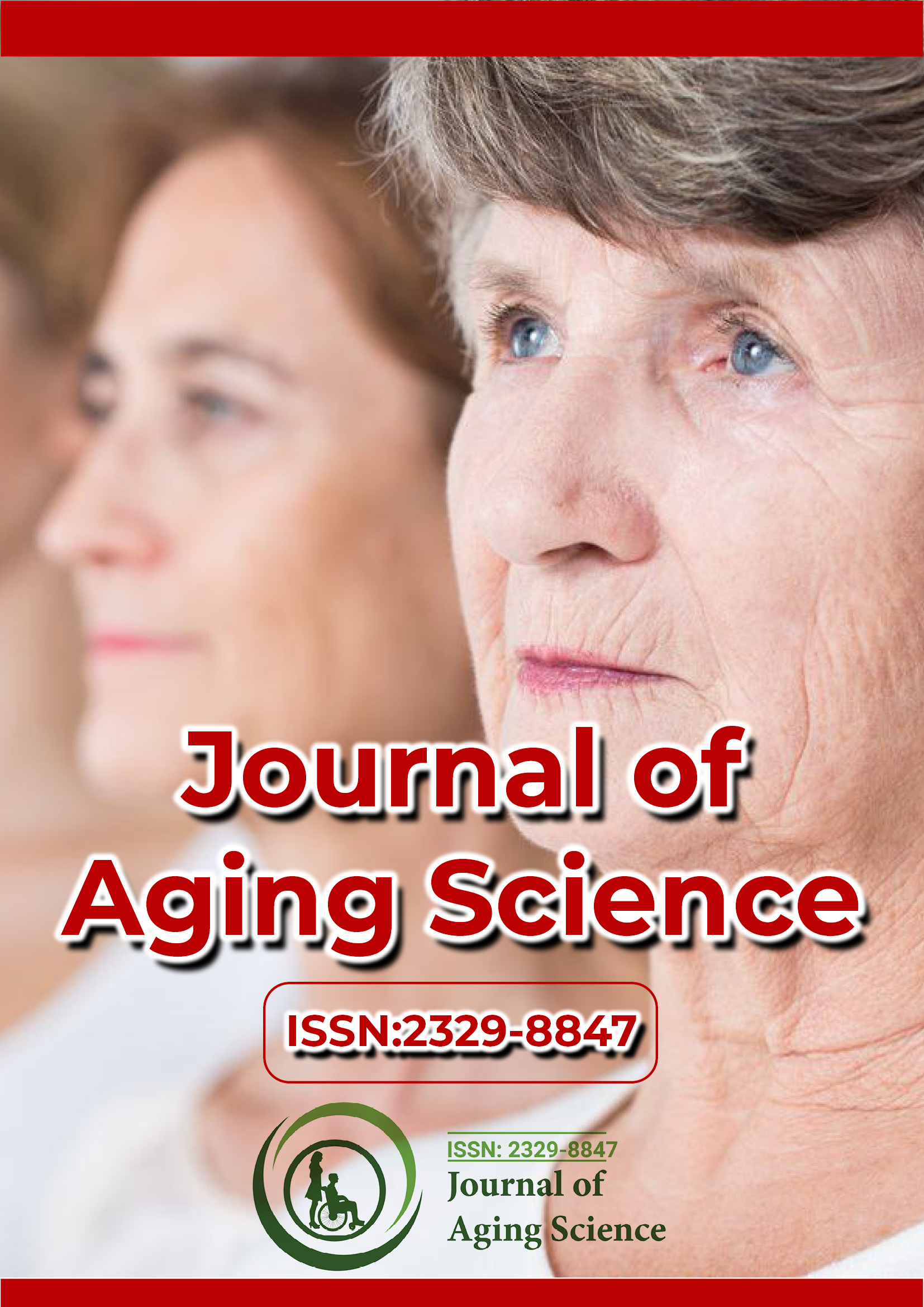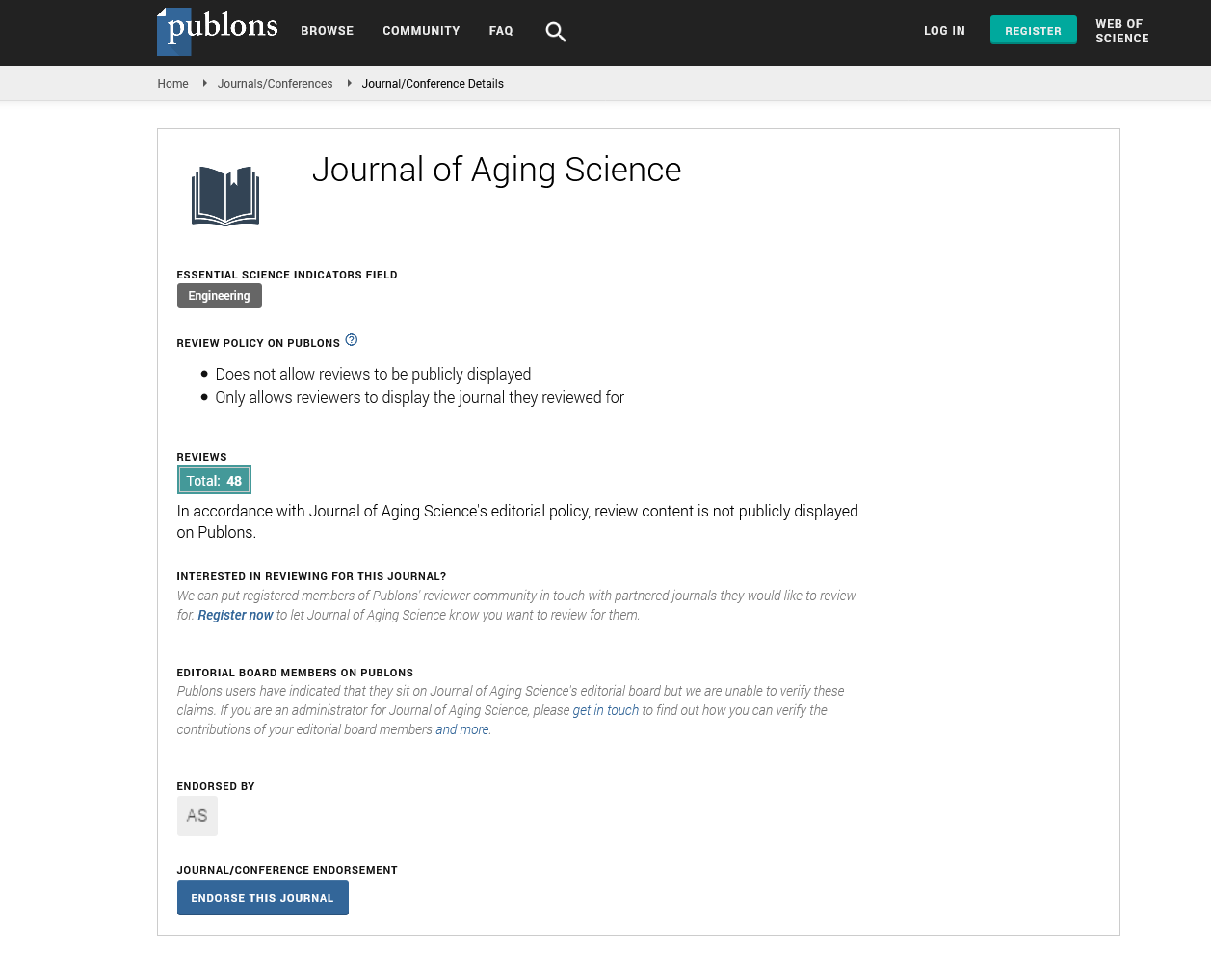Indexed In
- Open J Gate
- Academic Keys
- JournalTOCs
- ResearchBible
- RefSeek
- Hamdard University
- EBSCO A-Z
- OCLC- WorldCat
- Publons
- Geneva Foundation for Medical Education and Research
- Euro Pub
- Google Scholar
Useful Links
Share This Page
Journal Flyer

Open Access Journals
- Agri and Aquaculture
- Biochemistry
- Bioinformatics & Systems Biology
- Business & Management
- Chemistry
- Clinical Sciences
- Engineering
- Food & Nutrition
- General Science
- Genetics & Molecular Biology
- Immunology & Microbiology
- Medical Sciences
- Neuroscience & Psychology
- Nursing & Health Care
- Pharmaceutical Sciences
Commentary - (2024) Volume 12, Issue 4
Inflammaging: The Role of Chronic Inflammation in Aging and Age-Related Diseases
Yuma Maruyama*Received: 27-Nov-2024, Manuscript No. JASC-24-27785; Editor assigned: 29-Nov-2024, Pre QC No. JASC-24-27785 (PQ); Reviewed: 13-Dec-2024, QC No. JASC-24-27785; Revised: 20-Dec-2024, Manuscript No. JASC-24-27785 (R); Published: 26-Dec-2024, DOI: 10.35248/2329-8847.24.12.394
Description
Aging is a natural and inevitable process that impacts all living organisms. However, it is not merely a matter of time; it involves complex biological changes that affect cellular, tissue and systemic levels. One of the pivotal factors contributing to aging and age-related diseases is chronic, low-grade inflammation, a phenomenon termed "inflammaging." First described in the early 2000s, inflammaging refers to the persistent activation of the immune system with age, leading to harmful effects on health and an increased risk of chronic diseases such as cardiovascular disorders, diabetes, neurodegenerative diseases and cancer. Understanding the mechanisms behind inflammaging is critical for developing strategies to mitigate its impact and promote healthy aging.
What is inflammaging?
Inflammaging is characterized by a state of chronic, systemic and low-level inflammation that develops gradually with age. Unlike acute inflammation, which is a protective response to injury or infection, chronic inflammation persists over time and becomes detrimental. The key difference lies in the inability of the immune system to resolve inflammation effectively, leading to a prolonged inflammatory state.
This phenomenon arises from several interconnected factors, including the accumulation of cellular debris, oxidative stress, mitochondrial dysfunction and immune system dysregulation. The aging process results in a weakened ability to clear damaged cells and biomolecules, creating a pro-inflammatory environment. Over time, this sustained inflammatory state contributes to tissue damage, impaired cellular function and the development of age-related diseases.
Mechanisms underlying inflammaging
The mechanisms driving inflammaging are multifaceted and involve a complex exchange between innate and adaptive immunity, cellular stress responses and environmental factors.
Cellular senescence: Senescent cells, which are damaged or aged cells that no longer divide, play a central role in inflammaging. These cells secrete pro-inflammatory molecules, collectively known as the Senescence-Associated Secretory Phenotype (SASP). SASP includes cytokines, chemokines and growth factors that contribute to the inflammatory milieu. Senescent cells accumulate with age and their persistent presence increases systemic inflammation.
Mitochondrial dysfunction: Mitochondria are the primary energy producers in cells, but they also generate Reactive Oxygen Species (ROS) as byproducts. With age, mitochondrial efficiency declines, leading to increased ROS production and oxidative stress. This oxidative damage triggers inflammatory signaling pathways, perpetuating the cycle of inflammation.
Immunosenescence: The aging immune system undergoes significant changes, collectively termed immunosenescence. This includes reduced adaptive immune responses, such as diminished T-cell function and antibody production, coupled with overactive innate immune responses. The dysregulated immune system becomes less effective at resolving inflammation and more prone to chronic activation.
Gut microbiota dysbiosis: The gut microbiota, a diverse community of microorganisms residing in the digestive tract, plays an important role in modulating inflammation. Aging is associated with changes in gut microbiota composition, known as dysbiosis. This imbalance can lead to increased gut permeability ("leaky gut"), allowing microbial products like Lipopolysaccharides (LPS) to enter the bloodstream and trigger systemic inflammation.
Accumulation of Damage-Associated Molecular Patterns (DAMPs):
DAMPs are endogenous molecules released by damaged or dying cells. These molecules, including fragmented DNA and misfolded proteins, activate immune receptors and initiate inflammatory responses. With age, the accumulation of DAMPs contributes to a heightened inflammatory state.
Inflammaging and age-related diseases: The chronic inflammation associated with inflammaging is a major contributor to the pathogenesis of several age-related diseases.
Cardiovascular Diseases (CVD): Inflammaging accelerates atherosclerosis, the buildup of plaques in arteries, which is a leading cause of heart attacks and strokes. Pro-inflammatory cytokines promote endothelial dysfunction, oxidative stress and plaque instability, increasing the risk of cardiovascular events.
Type 2 diabetes: Chronic inflammation impairs insulin signaling and contributes to insulin resistance, a hallmark of type 2 diabetes. Inflammatory molecules like Interleukin-6 (il-6) and Tumor Necrosis Factor-Alpha (TNF-α) interfere with glucose metabolism and magnify metabolic dysfunction.
Neurodegenerative diseases: Inflammaging plays a critical role in the development of Alzheimer’s disease, Parkinson’s disease and other neurodegenerative conditions. Microglia, the brain’s immune cells, become overactivated with age, releasing proinflammatory cytokines that damage neurons and magnify disease progression.
Cancer: Chronic inflammation creates an environment conducive to tumor development. Inflammatory mediators can promote genetic mutations, angiogenesis and immune evasion, all of which facilitate cancer initiation and progression.
Osteoarthritis: The degeneration of joint cartilage in osteoarthritis is linked to inflammatory processes. Inflammaging contributes to the activation of catabolic enzymes and the destruction of cartilage, leading to joint pain and reduced mobility.
Strategies to mitigate inflammaging: While inflammaging is an inevitable aspect of aging, several strategies can help reduce its impact and promote healthy aging.
Caloric restriction and fasting: Caloric restriction and intermittent fasting have shown potential in reducing markers of inflammation and improving metabolic and immune function in both animal models and humans.
Emerging therapies: Advances in biotechnology, including gene editing, immunomodulation and personalized medicine, hold potential for targeting the root causes of inflammaging.
Conclusion
Inflammaging is a critical factor in the aging process and the development of age-related diseases. Its complex mechanisms involve cellular senescence, mitochondrial dysfunction and immune dysregulation, among others. While aging cannot be avoided, understanding inflammaging offers opportunities to intervene and promote healthier aging. By adopting lifestyle changes, exploring pharmacological options and controlling advances in science and technology, it is possible to mitigate the detrimental effects of chronic inflammation and enhance the quality of life in old age.
Citation: Maruyama Y (2024). Inflammaging: The Role of Chronic Inflammation in Aging and Age-Related Diseases. J Aging Sci. 12:394
Copyright: © 2024 Maruyama Y. This is an open-access article distributed under the terms of the Creative Commons Attribution License, which permits unrestricted use, distribution and reproduction in any medium, provided the original author and source are credited

